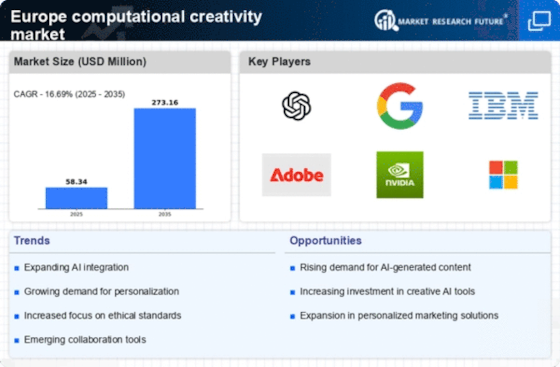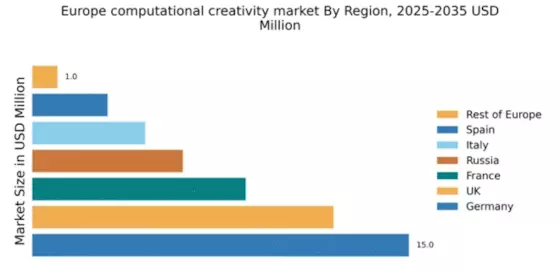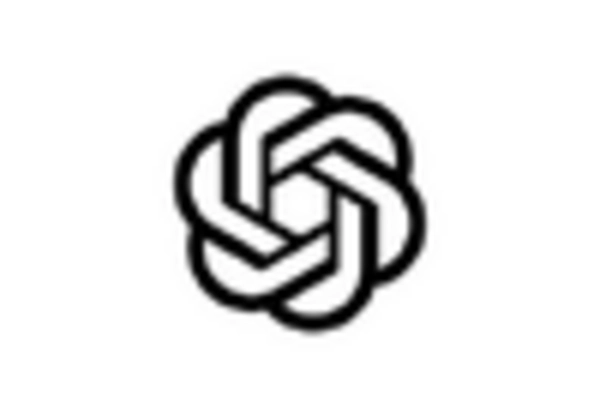Germany : Innovation Hub Driving Growth
Germany holds a commanding 15.0% market share in the computational creativity sector, valued at approximately €1.5 billion. Key growth drivers include a robust tech ecosystem, significant investment in AI research, and a strong emphasis on digital transformation across industries. Demand trends show increasing adoption in sectors like automotive design and media, supported by government initiatives promoting AI innovation and regulatory frameworks that encourage tech development. Infrastructure improvements, particularly in broadband and data centers, further bolster market potential.
UK : Strong Investment and Talent Pool
The UK commands a 12.0% market share, translating to around €1.2 billion in value. The growth is fueled by substantial investments in AI startups and a vibrant tech community, particularly in London and Cambridge. Demand for computational creativity is rising in advertising, gaming, and entertainment sectors. The UK government has implemented favorable policies to support AI development, including funding initiatives and regulatory frameworks that promote innovation while ensuring ethical standards. The competitive landscape features major players like DeepMind and Microsoft, enhancing the local business environment.
France : Cultural Richness Fuels Demand
France holds an 8.5% market share, valued at approximately €850 million. The market is driven by a blend of cultural industries and technological advancements, with Paris as a central hub for creative AI applications. Demand is particularly strong in fashion, art, and media, supported by government initiatives that promote digital creativity and innovation. Regulatory policies encourage collaboration between tech firms and cultural institutions, fostering a conducive environment for growth. The competitive landscape includes key players like IBM and Adobe, which are actively engaging in local partnerships.
Russia : Expanding Market with Unique Challenges
Russia's market share stands at 6.0%, valued at around €600 million. The growth is driven by increasing interest in AI technologies across various sectors, including manufacturing and entertainment. Demand trends indicate a rising adoption of AI in creative processes, supported by government initiatives aimed at enhancing digital infrastructure. However, regulatory challenges and geopolitical factors pose unique hurdles. Key cities like Moscow and St. Petersburg are central to the market, with local players emerging alongside international giants like NVIDIA, creating a competitive landscape.
Italy : AI in Design and Fashion
Italy captures a 4.5% market share, valued at approximately €450 million. The market is characterized by a strong focus on design and fashion, with cities like Milan leading the way in adopting computational creativity. Growth drivers include a rich cultural heritage that fuels demand for innovative design solutions and government support for digital transformation initiatives. The competitive landscape features both local artisans and major players like Adobe, creating a unique blend of traditional and modern approaches. The business environment is increasingly favorable for tech startups in the creative sector.
Spain : AI Adoption in Creative Industries
Spain holds a 3.0% market share, valued at around €300 million. The market is experiencing growth driven by increasing adoption of AI in creative industries such as film, music, and advertising. Demand trends indicate a shift towards digital solutions, supported by government initiatives promoting innovation and entrepreneurship. Key cities like Barcelona and Madrid are central to this growth, with a competitive landscape that includes both local startups and international players like Google. The business environment is evolving, with a focus on collaboration between tech and creative sectors.
Rest of Europe : Diverse Applications Across Regions
The Rest of Europe accounts for a modest 1.0% market share, valued at approximately €100 million. This sub-region encompasses a variety of niche markets, each with unique growth drivers and demand trends. Countries like Sweden and the Netherlands are seeing increased interest in AI applications in creative fields, supported by favorable regulatory environments. The competitive landscape is diverse, with local startups and smaller players gaining traction alongside larger firms. The business environment is characterized by innovation and collaboration, particularly in tech-driven creative sectors.


















Leave a Comment